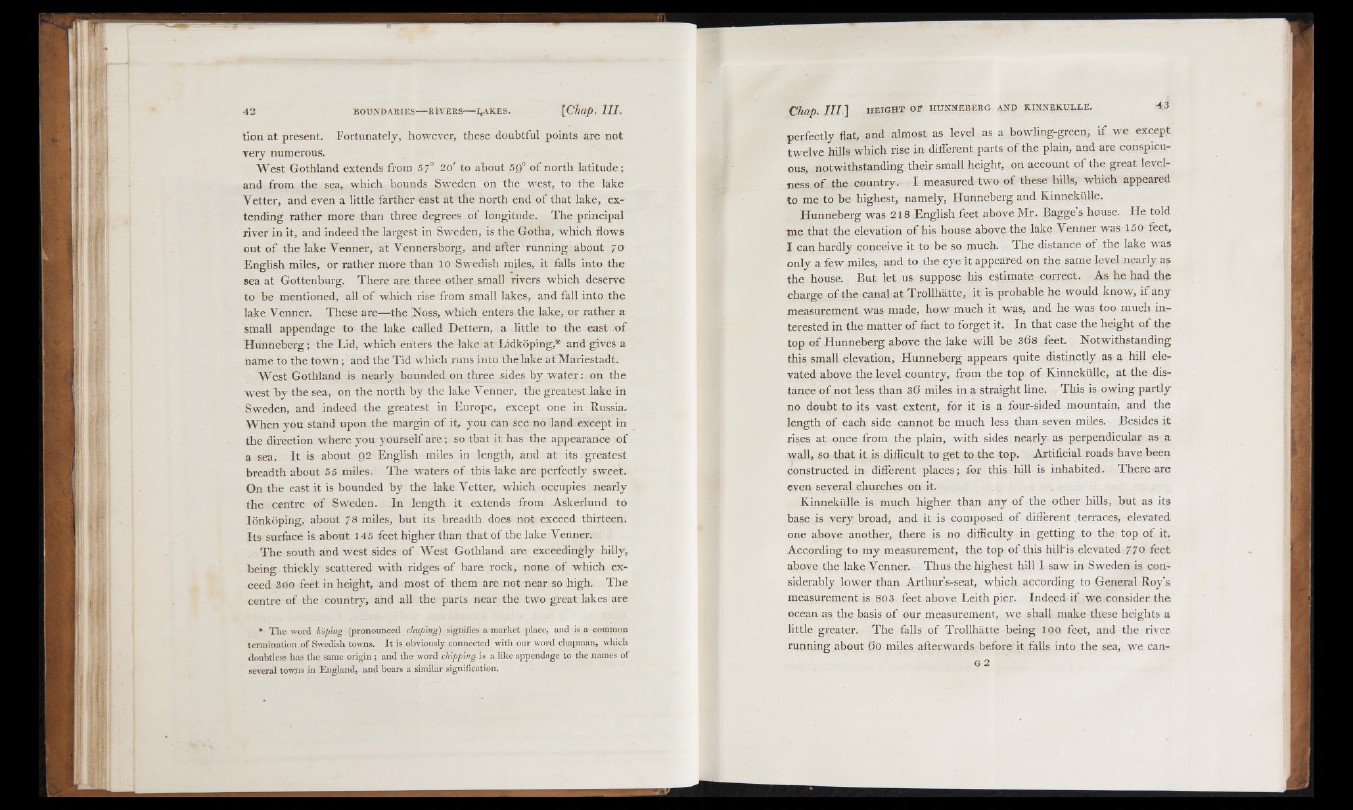
tion at present. Fortunately, however, these doubtful points are not
very numerous.
West Gothland extends from 57° 2 o' to about 5g° of north latitude;
and from the sea, which bounds Sweden on the west, to the lake
Vetter, and even a little farther east at the north end o f that lake, extending
rather more than three degrees of longitude. The principal
river in it, and indeed the largest in Sweden, is the Gotha, which flows
out of the lake Venner, at Vennersborg, and after running about 70
English miles, or rather more than 10 Swedish miles, it falls into the
sea at Gottenburg. There are three other small rivers which deserve
to be mentioned, all of which rise from small lakes, and fall into the
lake Venner. These are— the Noss, which enters the lake, or rather a
small appendage to the lake called Dettern, a little to the east of
Hunneberg; the Lid, which enters the lake at Lidkoping,* and gives a
name to the town; and the Tid which runs into the lake at Mariestadt.
West Gothland is nearly bounded on three sides by water: on the
west by the sea, on the north by the lake Venner, the greatest lake in
Sweden, and indeed the greatest in Europe, except one in Russia,
When you stand upon the margin of it, you can see no land except in
the direction where you yourself a re; so that it has the appearance of
a sea. It is about g2 English miles in length, and at its greatest
breadth about 55 miles. The waters of this lake are perfectly sweet.
On the east it is bounded by the lake Vetter, which occupies nearly
the centre of Sweden. In length it extends from .Askerlund to
Ionkoping, about 78 miles, but its breadth does not exceed thirteen.
Its surface is about 145 feet higher than that of the lake Venner.
The south and west sides of West Gothland are exceedingly hilly,
being thickly scattered with ridges of bare rock, none of which exceed
300 feet in height, and most of them are not near so high. The
centre of the country, and all the parts near the two great lakes are
* The word koping (pronounced cliuping) signifies a market place, and is a common
termination.of Swedish towns. It is obviously connected with our word chapman, which
doubtless has the same origin; and the word chipping is a like appendage to the names of
several towns in England, and bears a similar signification.
perfectly flat, and almost as level as a bowling-green, i f we except
tvvelve hills which rise in different parts of the plain, and are conspicuous,
notwithstanding their small height, on account o f the great levelness
of the country. I measured two of these hills, which appeared
to me to be highest, namely, Hunneberg and Kinnektille.
Hunneberg was 2 18 English feet above Mr. Bagge’s house. He told
me that the elevation o f his house above the lake Venner was 150 feet,
I can hardly conceive it to be so much. The distance o f the lake was
only a few miles, and to the eye it appeared on the same level nearly as
the house. But let us suppose his estimate correct. As he had the
charge of the canal at Trollhatte, it is probable he would know, if any
measurement was made, how much it was, and he was too much interested
in the matter of fact to forget it. In that case the height o f the
top of Hunneberg above the lake will be 368 feet. Notwithstanding
this small elevation, Hunneberg appears quite distinctly as a hill elevated
above the level country, from the top o f Kinnekiille, at the distance
o f not less than 36 miles in a straight line. This is owing partly
no doubt to its vast extent, for it is a four-sided mountain, and the
length o f each side cannot be much less than seven miles. Besides it
rises at once from the plain, with sides nearly as perpendicular as a
wall, so that it is difficult to get to the top. Artificial roads have been
constructed in different places; for this hill is inhabited. There are
even several churches on it.
Kinnekiille is much higher than any of the other hills, but as its
base is very broad, and it is composed o f different .terraces, elevated
one above another, there is no difficulty in getting to the; top o f it.
According to my measurement, the top of this hill" is elevated 77 o feet
above the lake Venner. Thus the highest hill I saw in Sweden is considerably
lower than Arthur’s-seat, which according to General Roy’s
measurement is 803 feet above Leith pier. Indeed if we consider the
ocean as the basis o f our measurement, we shall make these heights a
little greater. The falls of Trollhatte being 100 feet, and the river
running about 6 o miles afterwards before it falls into the sea, we can